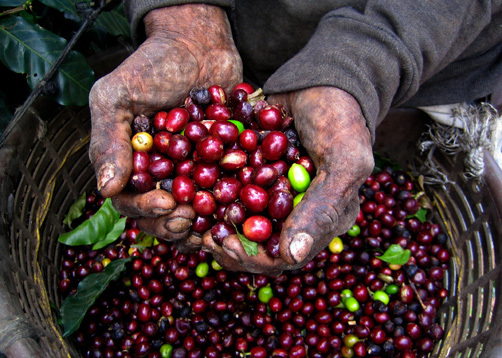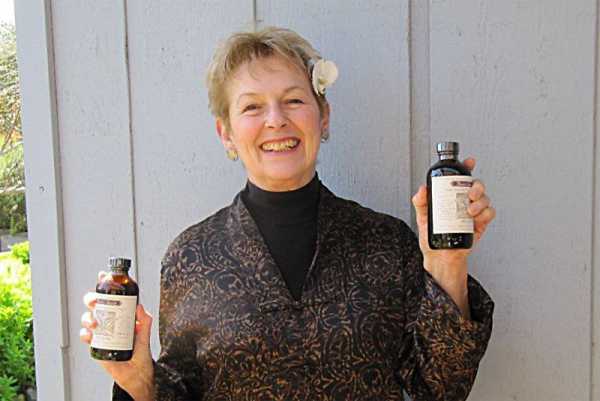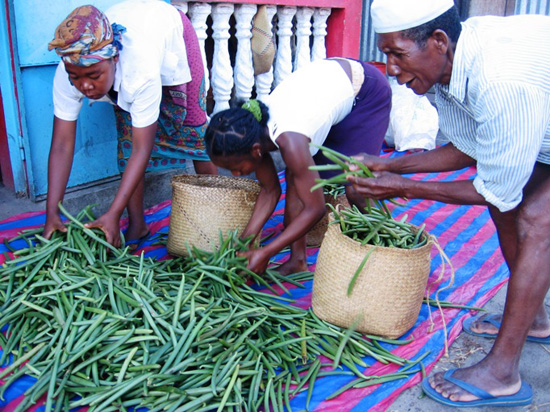
I'm amazed at how superior your vanilla is!
– Des, The Grommet

Courtesy of Courtenay Dunk: www.spicelines.com
Ruperto Opoch has a natural grace born of equal parts humility and excellence at his chosen metier. He is the third generation of his family to run Predio Guayabal, a small organic finca outside Coatepec, the coffee-growing capital of Veracruz. At 70-odd years, his thick, carefully combed hair is white and his face bronzed by a lifetime of working in the fields-yet he is as dignified in his denim work shirt, fleece-lined jacket and jeans as a banker in a proper Savile Row suit. It is the deep sadness in his eyes that is arresting as he explains whatit is like to grow wonderful organic coffee that no one will buy. “We are starving,” he says.
Twenty percent of Mexico’s coffee comes from the state of Veracruz. The finest-designated Altura–is grown in the rich volcanic soil of the mountains around the pretty colonial city of Coatepec. The conditions are just right for the production of high quality Arabica beans: moderate temperatures, an elevation of 4,000 feet, and plenty of rain and shade. Yet Coatepec coffee–prized by connoisseurs for its medium acidity, good balance and smoothness of taste-is virtually unknown in the United States.
Right now I am sipping some of that coffee with Don Ruperto and my head is starting to spin. It is delicious, light in color, brightly flavored, tasting of toasted nuts. (One reviewer has likened it to “a good light white wine delicate in body, with a pleasantly dry, acidy snap.”) The four of us—including Liliana and Deborah-are sitting at a round table with an inlaid surface, scalloped edges and gnarled roots for a base. It is a made of blond wood from aged coffee trees, as are a chess set, coffee cups and sculpture on display in Don Ruperto’s Museum of Coffee. Outside, under the high arched portal of this beautiful white stucco hacienda are vintage roasters and grinders, relics of a bygone era.
“Everything we do is organic and natural,” explains Don Ruperto, as he stirs his coffee. “We plant in the traditional Mexican way, 1,600 plants for each hectare. In Central America, they plant 5,000 per hectare.” He pauses while Liliana translates for us, anxious that we understand the implications of what he is saying. “Coffee is very demanding. It must be grown in the shade, but not of just any tree. It must be grown under the chalahuite and other arboles de vaina. When they drop their leaves, it enriches the earth and makes the coffee plants stronger. I have coffee trees that are 100 years old.”
It is poor taste to ask a landowner how many hectares he owns, but I do. Don Ruperto reluctantly admits that the finca has dwindled to 20 hectares. In 2002, international coffee prices hit an all time low of about 50 cents per pound, the nadir of a decade long downward spiral resulting from increased world production and dramatically lower prices paid by the major coffee companies. All over Veracruz coffee trees have been ripped out and land replanted for forestry. Desperate workers have surged across the U.S. border looking for work. Some who stayed, like Don Ruperto, have had to sell their land, bit by bit.
Technically, things are looking up. For 2006, coffee prices are expected to stabilize at $1.10 to $1.20 cents a pound, but as Nestor Osorio, the Executive Director of the International Coffee Organization told a meeting of specialty coffee buyers, “…time is still needed to enable producing countries to recover from structural problems created by many years of low coffee prices, which cannot be easily solved after just one year of improved prices.” For many small farmers, the message is more urgent: Their way of life is over.
“We want the big coffee companies to give us a good price,” says Don Ruperto. “But they say our beans are too expensive and they won’t buy them.” He gazes at the spindly young coffee trees in the patio. “A few years ago I had the idea of selling a coffee drink in bottles and I took it to someone at the university. They said it was impossible and then they stole the idea. Now bottled coffee is being sold as a soft drink in France. And we are starving.”
Later that day, we drive to the waterfalls outside the nearby town of Xico. The two-lane road takes us through flourishing coffee plantations, where tall coffee trees with thick trunks grow six to seven feet tall. Some are covered with sweet-scented white blossoms, others are laden with clusters of berries in various stages of ripeness–green, yellow and red. Towering over them is a dappled canopy of shade trees, punctuated by monstrous banana plants with bunches of upward-growing green fruit.Lichen-encrusted walls lead to elaborate iron gates and mossy cobblestoned roads. Somewhere, around the bend, is a hidden hacienda. It all looks like paradise, until you know the back story:
A May 29, 2001 article on Dow Jones Newswire (“Coffee crisis sends Mexico producers to death in Arizona” by Maja Wallengren) reported that most of the 16 Mexican immigrants who died in the Arizona desert that month were small coffee farmers from the state of Veracruz. Their smugglers, who left them without water, were paid up to $2,000 per person to arrange illegal entry into the United States. “Most of the Veracruz group turned to local money lenders. In return they handed over land titles for their small 1/2 hectare coffee plots as guarantee for the loans, and the relatives may now lose their land to the lenders.”
Editor’s note: You can help Veracruz coffee growers by asking your local specialty coffee store to order Mexican Altura Coatepec Coffee.
If you go to Veracruz, be sure to visit the lovely colonial city of Coatepec. Café Opoch, where you can sip a cup of coffee or buy Don Ruperto’s beans, and his coffee museum are located at 5 de Mayo No 66 at the corner of Allende. Telephone: (228) 816-07-07.
Posted by SpiceLines on May 22, 2006 9:05 PM | Permalink
I was given a small bottle of Rain’s Choice in a gift basket and I have been hooked ever since. The flavor makes all of my baking so much better! I will never use grocery store vanilla again!


© 2021. All Rights Reserved
Designed/Developed by Kat & Mouse